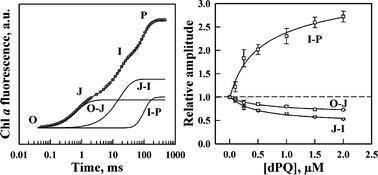Sigmoidal reduction kinetics of the photosystem II acceptor side in intact photosynthetic materials during fluorescence induction
Abstract
Illumination of dark-adapted photosynthetic samples leads to fluorescence induction (FI) that can be described by a triphasic O-J-I-P fluorescence rise. Its kinetics follows the accumulation of reduced photosystem II (PSII) acceptors. In isolated thylakoid membranes, FI is often used to study photosynthetic electron transport. A simple quantitative analysis method was recently developed to fit these FI traces and also lead to a better understanding of action sites of artificial

- This article is part of the themed collection: Photosynthesis from molecular perspective: towards future energy production

 Please wait while we load your content...
Please wait while we load your content...